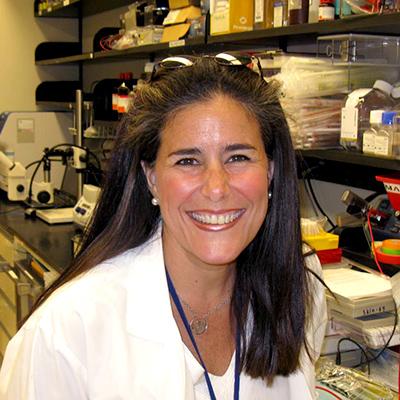
Research Topics
The pathways that regulate epidermal differentiation and the formation of a functional skin barrier have been a central topic of investigation in epidermal biology. Our research efforts have focused on characterizing the transcriptional regulatory networks and signaling pathways linked to epidermal differentiation and wound healing.
Epidermal Differentiation and Inflammatory Disorders
Epidermal homeostasis results from a balance between keratinocyte proliferation and differentiation, with alterations to this balance leading to cancer. Using animal models, we have demonstrated the central role of the transcriptional regulator during epidermal differentiation. Through a combination of transcriptomic and bioinformatic analyses, we have identified a DLX3-dependent network that regulates cell cycle and the activated ERK- and STAT3-dependent signaling pathways that are crucial to maintaining cutaneous homeostasis. The epidermal conditional deletion of DLX3 leads to the disruption of skin barrier formation. It is linked to epidermal hyperplasia and the development of an inflammatory response, characterized by the accumulation of IL-17-producing T cells. Our studies also provide a novel understanding of the signaling networks regulating squamous tumorigenesis.
Wound Healing
Oral wounds are considered an ideal prototype of adult tissue repair due to their intrinsic ability for scarless accelerated wound healing. Our studies have shown that wound-activated transcriptional networks are active in oral mucosa at a basal state, priming this tissue for wound repair by controlling epithelial cell differentiation. We have determined the capability of the SOX2 and PITX1 transcription factors to reprogram cutaneous keratinocytes for accelerated wound resolution. Furthermore, we found that SOX2 promotes keratinocyte migration and angiogenesis through the upregulation of EGFR ligands and activation of the ERK/MAPK pathway. In contrast to acute cutaneous and oral wounds, chronic non-healing wounds do not resolve and are characterized by deregulated inflammation. This is due to ineffective recruitment and activation of macrophages and neutrophils. We are currently focused on identifying pathways responsible for the downregulation of inflammation that will be pivotal for diagnostics and the development of potential therapeutics.
Ectodermal Dysplasias and Ectodermal Appendage Development
Ectodermal dysplasias are a group of heritable pathological disorders that result from anomalies in epithelial/mesenchymal-derived appendage formation. The importance of DLX3 is underscored by the effects of mutations found in patients with autosomal dominant Tricho-Dento-Osseous (TDO) syndrome. We have demonstrated the crucial role of DLX3 in epidermal development and tooth and hair formation through direct regulation of specific sets of keratins. Using genetic and intraoral examination data from human patients, we identified several missense polymorphisms in keratins that lead to a higher risk for dental caries.
Biography
Maria Morasso, Ph.D. received an M.Sc. in Immunology and a Ph.D. in Biochemistry from the Instituto Venezolano de Investigaciones Científicas, Venezuela. Her postdoctoral training was in the Laboratory of Molecular Genetics in the National Institute of Child Health and Human Development (NICHD), NIH. In 2000, Dr. Morasso moved to the National Institute of Arthritis and Musculoskeletal and Skin Diseases (NIAMS), NIH where she is currently a senior investigator and chief of the Laboratory of Skin Biology. Dr. Morasso is also serving as an adjunct investigator at the Center for Cancer Research, NCI.
Selected Publications
- Iglesias-Bartolome R, Uchiyama A, Molinolo AA, Abusleme L, Brooks SR, Callejas-Valera JL, Edwards D, Doci C, Asselin-Labat ML, Onaitis MW, Moutsopoulos NM, Gutkind JS, Morasso MI. Transcriptional signature primes human oral mucosa for rapid wound healing. Sci Transl Med. 2018;10(451).
- Nayak S, Jiang K, Hope E, Cross M, Overmiller A, Naz F, Worrell S, Bajpai D, Hasneen K, Brooks SR, Dell'Orso S, Morasso MI. Chromatin Landscape Governing Murine Epidermal Differentiation. J Invest Dermatol. 2023;143(7):1220-1232.e9.
- Sawaya AP, Stone RC, Brooks SR, Pastar I, Jozic I, Hasneen K, O'Neill K, Mehdizadeh S, Head CR, Strbo N, Morasso MI, Tomic-Canic M. Deregulated immune cell recruitment orchestrated by FOXM1 impairs human diabetic wound healing. Nat Commun. 2020;11(1):4678.
- Williams DW, Greenwell-Wild T, Brenchley L, Dutzan N, Overmiller A, Sawaya AP, Webb S, Martin D, NIDCD/NIDCR Genomics and Computational Biology Core, Hajishengallis G, Divaris K, Morasso M, Haniffa M, Moutsopoulos NM. Human oral mucosa cell atlas reveals a stromal-neutrophil axis regulating tissue immunity. Cell. 2021;184(15):4090-4104.e15.
- Bajpai D, Mehdizadeh S, Uchiyama A, Inoue Y, Sawaya A, Overmiller A, Brooks SR, Hasneen K, Kellett M, Palazzo E, Motegi SI, Yuspa SH, Cataisson C, Morasso MI. Loss of DLX3 tumor suppressive function promotes progression of SCC through EGFR-ERBB2 pathway. Oncogene. 2021;40(21):3680-3694.
Related Scientific Focus Areas


Molecular Biology and Biochemistry
View additional Principal Investigators in Molecular Biology and Biochemistry


This page was last updated on Thursday, October 31, 2024